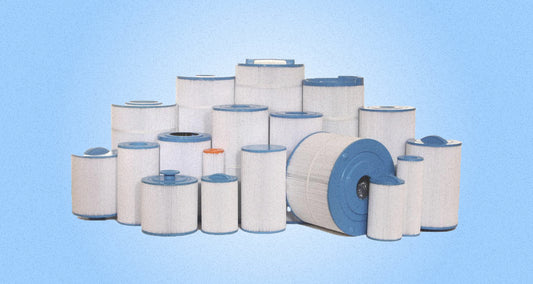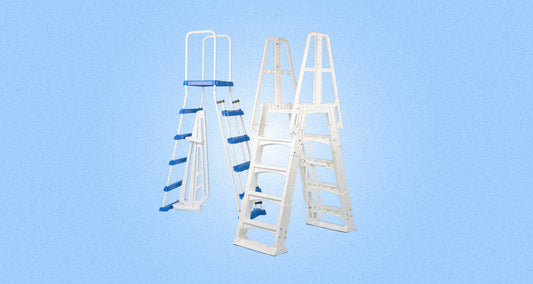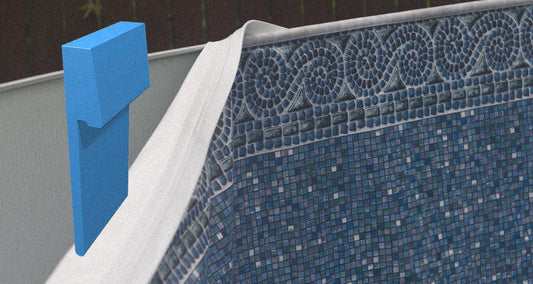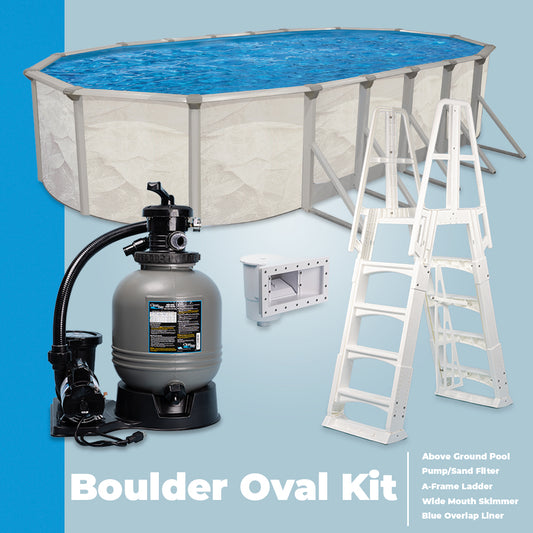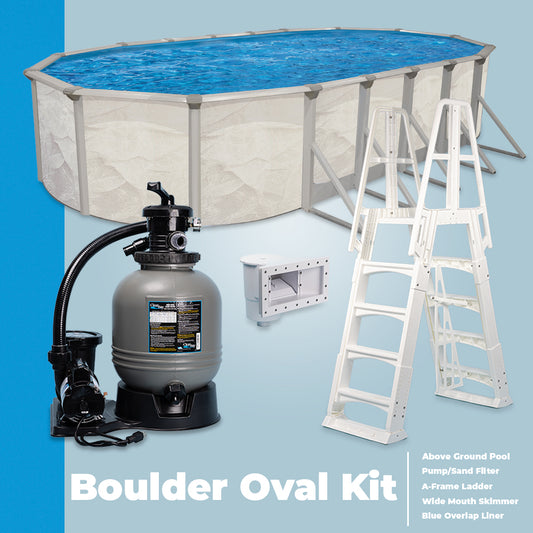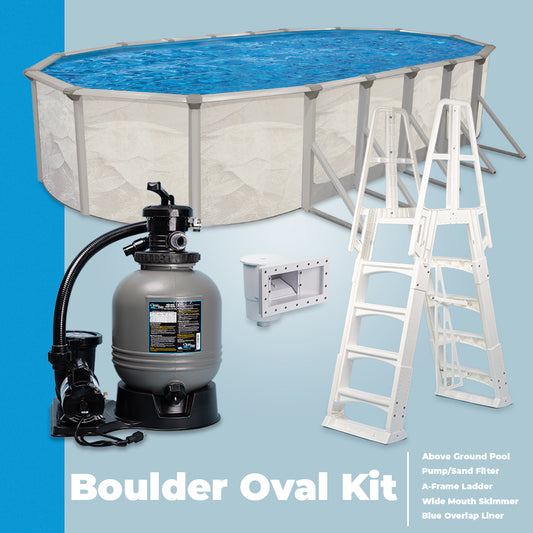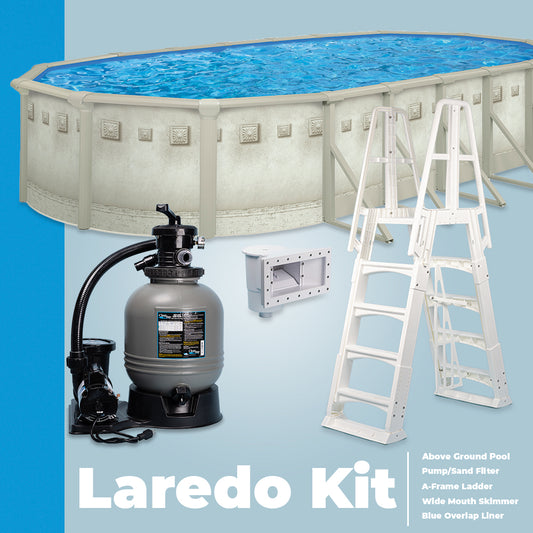HELP CENTER
What wall height should I choose? 48 vs 52 vs 54
Pool wall height is chosen based on personal preference unless you are replacing a pool with an existing deck and need an exact fit. Typically a pool is filled 4 inches from the top and has sand on the bottom underneath the liner.
– A 48”pool wall typically has 42” of water
– A 52” pool typically has 46” of water
– A 54” pool typically has 48” of water
How do I determine the right size pool for my backyard?
We recommend the following exercise in order to determine the right size pool for your backyard:
1. Using your imagination, locate where want the center of your new pool to be.
2. Place a stake or stick into the ground at the center point.
3.(For this example, we will assume the pool you have in mind is 24 ft. round.)Put a tape measure on top of the stake, and measure out 12ft from the center point.
4 . As you walk the circle with your measuring tape, use a bottle of spray paint or baby powder to outline the distance. This will give you an accurate idea of how large the pool will be in your yard. You can adjust your desired size based on the outcome.
Should I choose a resin or a steel pool?
Resin and steel are both heavy-duty materials used for pool frames. Resin material is plastic. Therefore, a resin pool still has a wall made of steel but every other part of it is made of resin. Resin pools are typically more expensive than steel pools, but they’re also rust and corrosion free. The zinc coating on steel pools adds a layer of protection, but this coating breaks down over time. This takes many years to occur, so the pool frame is still built to last a long time. Steel is less expensive and is heavier and more solid than resin. In extremely cold or hot temperatures, resin frames are vulnerable to cracking, while steel can hold up to these conditions. There are pros and cons to both options, so the best choice depends on your budget and your personal preference.
What is a Salt Friendly pool?
As you may know, saltwater can be extremely corrosive to metal. Therefore, pools that are deemed “Saltwater Friendly” have been manufactured with materials that are more durable and longer lasting, causing them to be more resistant to corrosion and rust. Salt-friendly pools have high quality resin parts ensuring the pool will not rust in those areas.
What are the advantages of a saltwater system and is it really chlorine free?
Saltwater is gentler on the eyes and skin, provides softer water and is safer than chlorine. Saltwater systems are less maintenance, but are also more expensive. Many consumers have the misconception that saltwater eliminates the use of chlorine, but a saltwater pool is not actually chlorine-free. It simply utilizes added salt and a chlorine generator instead of direct addition of chlorine.
What is the difference between Beaded, Uni-Bead and Overlap liners?
The main difference between these liners is how they are installed and attached to the pool wall.
Overlap Pool Liners:are the most economical option and are easy to install. They attach to the pool wall with coping strips that hold the liner to the pool wall. A coping strip is a piece of plastic that acts like a wide paper clip that runs along the top of your pool wall. Since it “overlaps” the swimming pool wall from the inside, the coping strip ensures that the liner is held firmly in place. Because overlapping may cause unevenness when installing, Overlap designs are typically limited to a solid color or uniform patterns.
Beaded Pool Liners:are the easiest to replace and come in a wide array of designs. Using a bead receiver that hangs over the top of the pool wall, the Beaded liner simply snaps into the receiver giving you an even and consistent look. Because they install evenly around the pool wall, Beaded liners flaunt beautiful designs and patterns including wall borders and tile trims.
Unibead Beaded Liners:are the ultimate in versatility and have a two-in-one feature that allows you to replace an Overlap liner with a Unibead liner. Unibead liners have the option to be used with a bead receiver or as a J-Hook liner. If you don’t have a bead receiver, simply hook the line onto the rim of the pool wall. If you have a bead receiver, carefully remove the J-Hook portion of the Unibead system and install like a beaded liner by snapping the liner into place. Both give you a clean look without any excess material hanging over the edge like in an Overlap liner. The Unibead provides all the benefits of protective liner and the freedom to use patterns found only on beaded liners.
What things should I consider when choosing a liner pattern?
The floor pattern is what’s most visible so choose a floor pattern you really like. The border pattern typically falls at the water level and is usually not as noticeable when you are next to the pool.
Darker blue colors hide dirt and debris on the pool floor but light blue colors don’t have as heavy ink coverage, which means less fading.
Choosing a liner design depends on your personal preference so we offer a wide variety of options to fit your unique style.
Which entry system should I choose?
When choosing an entry system you should consider the following:
– Pool owners with small children should always choose a ladder that flips up and rolls into a lock position in order to prevent children from entering the pool while unsupervised. In addition, ensure the ladder you choose fits against the interior pool wall and leaves no space where children may slip under and get stuck.
– Average weight of people using the pool – pool ladders typically hold up to 300 pounds.
– Average age of people using the pool – for young children and elderly swimmers you will want to choose a ladder with sturdy handrails
How do I choose the right size filter/pump for my pool?
When choosing a filter, a helpful tip is to choose one with at least 1 square foot per 10,000 gallons pool capacity.
A helpful tool when choosing a pump is for pools up to 24 ft round, use a 1 HP pump and for pools over 24 ft round, use a 1.5 HP pump.
The same is true of oval pools, for pools up to 15X30 oval use a 1HP pump and for pools over 15X30 use a 1.5HP pump.
What pool cleaner should I buy?
There are several types of pool cleaners – suction, pressure and robotic. Determining the best cleaner for your pool is based on preference, budget and the level of maintenance you wish to invest.
Suction sidecleaners work with the dedicated suction line in your pool. Suction side pool cleaners attach to the suction line and utilize the suction to propel the cleaner throughout the pool while scrubbing the pool surface, eliminating dirt and debris from your pool.
Pressure sidecleaners utilize an existing pressure side line to propel the cleaner throughout your pool. The water returned back into your pool fuels the cleaner, but it can require an additional booster pump to run. Unlike suction side cleaners, pressure side cleaners do not use your pool’s filtration system to filter out debris. Pressure side cleaners use a filtration bag to contain dirt and debris, relieving pressure and wear on your filtration system.
Robotic pool cleaners do not use your existing pool equipment and run off the power from your house. They free up pressure on your pool equipment and reduce overall power costs and consumption while providing superior cleaning power. Robotic pool cleaners support simple “plug and play” operation and pick up large and small debris in the built-in filtration system. Often times, robotic pool cleaners clean and scrub the pool floor, steps and even the waterline, eliminating the need to clean your pool walls with a brush. The reduced maintenance and wear on pool equipment makes robotic pool cleaners ideal for most pools.
What is wall foam and do I need it for my pool?
Wall foam adds an extra layer of protection between the liner and metal components of the pool. It can protect against punctures from the wall bolts or any other sharp edges of the pool wall or components. Wall foam is not critical, but simply adds an extra layer of protection to you pool.
What is a liner pad and do I need it for my pool?
Liner pad is installed on the ground and protects liners from rocks, roots and grass that may come up into your pool liner.
What is coving and do I need it for my pool?
Cove is a slight angle of material against the pool wall (usually sand, sifted fill, or foam) that is a critical part of your pool system. It keeps the weight of the water inside the pool and prevents the liner from ballooning out under the bottom of the pool wall. Many times pool warranties are voided if pool cove isn’t used.
CHECK OUT OUR ABOVE GROUND POOL KITS
-
12' X 24' X 52 ECHO POOL PACKAGE
Regular price $2,468.50Regular priceUnit price per -
18' X 33' X 52 ECHO POOL PACKAGE
Regular price $3,608.05Regular priceUnit price per -
16' X 32' X 52 ECHO POOL PACKAGE
Regular price $3,419.39Regular priceUnit price per -
18' X 33' X 52 MILLENIUM POOL PACKAGE
Regular price $3,890.74Regular priceUnit price per

